Vintage and New: Revisiting The Night Land with James Stoddard
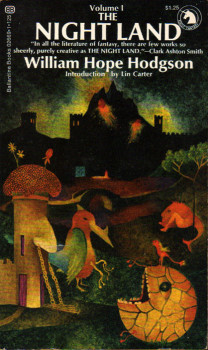 William Hope Hodgson (1877-1918) was an English author and poet who died in Flanders Fields (how poetic) at the age of 40, his career cut short by an artillery shell. Perhaps you’ve heard of him?
William Hope Hodgson (1877-1918) was an English author and poet who died in Flanders Fields (how poetic) at the age of 40, his career cut short by an artillery shell. Perhaps you’ve heard of him?
Maybe not. Though the recognition will be significantly higher among readers of this site, for the general public his is a pretty obscure name (at least until a major HBO series drops references to his work, a la True Detective and Robert W. Chambers).
If you have heard of him, it’s likely because H.P. Lovecraft considered Hodgson’s novels to have been among the most brilliant works of weird horror, and more recent writers like Gene Wolfe and China Mièvelle concur.
Ironically, Lovecraft himself was once nearly forgotten — like Hodgson, he was well served by literary executors who worked tirelessly to keep his work alive until he could be more widely recognized and take his rightful place in the canon. Hodgson’s widow and his sister-in-law both managed to keep his works in print so that the likes of Lovecraft could discover him. Unlike Lovecraft, much wider recognition has not been — and likely will not be — forthcoming, and that is largely Hodgson’s own fault.
Most new readers of Hodgson come to him through recommendations by influential popular writers; two of the most influential cheerleaders have been Lovecraft and C.S. Lewis. Although there could hardly be two more different authors than Lovecraft and Lewis, and though their fan base probably does not much overlap, both were struck by the power of Hodgson’s weird, startling imagination and had the highest praise for two novels in particular: The House on the Borderland (1908) and The Night Land (1912).
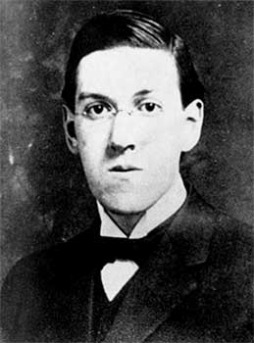 Yet everyone who praises Hodgson does so with qualifications. Lovecraft, in his seminal long essay, Supernatural Horror in Literature (1927), opens his remarks on Hodgson’s oeuvre as follows:
Yet everyone who praises Hodgson does so with qualifications. Lovecraft, in his seminal long essay, Supernatural Horror in Literature (1927), opens his remarks on Hodgson’s oeuvre as follows:
“Of rather uneven stylistic quality, but vast occasional power in its suggestion of lurking worlds and beings behind the ordinary surface of life, is the work of William Hope Hodgson, known today far less than it deserves to be. Despite a tendency toward conventionally sentimental conceptions of the universe, and of man’s relation to it and to his fellows, Mr. Hodgson is perhaps second only to Algernon Blackwood in his serious treatment of unreality. Few can equal him in adumbrating the nearness of nameless forces and monstrous besieging entities through casual hints and insignificant details, or in conveying feelings of the spectral and the abnormal in connection with regions or buildings.”
In hindsight we can add Lovecraft as one of those few who could equal him, and indeed, that last sentence seems to be what Lovecraft was all about in his own fiction. It seems that Lovecraft aimed for what he perceived Hodgson to be getting at, while correcting the failure, as he saw it, of “a tendency toward conventionally sentimental conceptions of the universe, and of man’s relation to it . . .”
About The Night Land specifically, Lovecraft’s critique is harsh: “It is told in a rather clumsy fashion . . . and is seriously marred by painful verboseness, repetitiousness, artificial and nauseously sticky romantic sentimentality, and an attempt at archaic language even more grotesque and absurd than that in [his first novel] Glen Carrig.”
Some contemporary readers find Lovecraft’s prose challengingly archaic, so when he criticizes someone else on those very grounds, that’s saying something! Given that critical drubbing, how could The Night Land rate so highly by Lovecraft’s lights? The master of horror goes on to explain:
“Allowing for all its faults, it is yet one of the most potent pieces of macabre imagination ever written. The picture of a night-black, dead planet, with the remains of the human race concentrated in a stupendously vast metal pyramid and besieged by monstrous, hybrid, and altogether unknown forces of the darkness, is something that no reader can ever forget.”
The back-cover copy for Wildside Press’s 2005 edition of The Night Land describes the book as a “brilliant but ultimately flawed masterpiece.” What a counterintuitive description to slap on a book you’re trying to sell, huh? This is ultimately flawed, but you should read it. The blurb does conclude by noting it is “[a]n unforgettable vision of the future!” That claim of “unforgettable,” though, seems to come with the unspoken disclaimer if you can get through it.
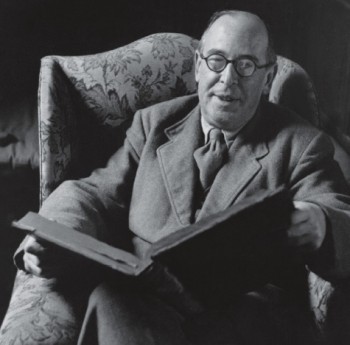
C.S. Lewis, another avowed fan of “the unforgettable sombre splendor of the images” in Hodgson, aimed criticism at the same targets that Lovecraft did; namely, its “sentimental and irrelevant erotic interest and . . . flat archaism of style.”
Lin Carter introduced a generation of new readers to The Night Land, split into two volumes as the forty-ninth and fiftieth installments of the Ballantine Adult Fantasy or “Sign of the Unicorn” series (note: westkeith is working through every volume in that series here at Black Gate), with his own disclaimer: “The Night Land is a work of sustained imaginative vision without equal in literature, but it is dreadfully overwritten, overlong, and verbose and repetitive to the point of shameful self-indulgence. The High Victorian love scenes and romantic dialogue are excruciating to the modern taste and hurt the strength of the book.”
One little clarification to Carter’s criticism of the “romantic dialogue”: there is none. No dialogue of any kind, in fact. There is no actual dialogue anywhere in the book. Oh, people do converse, but no direct speech is provided; it is all paraphrased by the narrator — yet another stumbling block to readers fully engaging in the wondrous story being woven.
Which brings us to James Stoddard, whose early taste in fantasy was shaped by the Ballantine Adult Fantasy series. Never heard of Stoddard? In 1998, he was a hot new name on the scene. From an author’s bio:
“James Stoddard’s debut novel The High House won the Compton Crook Award for Best Fantasy Novel by a new author, placed in the Locus Top Ten for Best SF/Fantasy Book of the Year, and was named one of five finalists for the Mythopoeic Award, an award given to works reflecting the spirit of the writing of C.S. Lewis, Charles Williams, and J.R.R. Tolkien.”
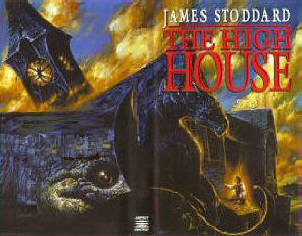 Not mentioned there was that in 2000, co-editor Gabe Dybing and I added The High House to our Best Books of Wonder list, compiled for our small-press magazine MOOREEFFOC, alongside works by the likes of Tolkien, George MacDonald, and G.K. Chesterton. (How did that accolade get overlooked? Okay, I’m being facetious.)
Not mentioned there was that in 2000, co-editor Gabe Dybing and I added The High House to our Best Books of Wonder list, compiled for our small-press magazine MOOREEFFOC, alongside works by the likes of Tolkien, George MacDonald, and G.K. Chesterton. (How did that accolade get overlooked? Okay, I’m being facetious.)
The High House was a love letter of sorts to the Ballantine “Sign of the Unicorn” series and all the spellbinding writers it introduced to Stoddard — E.R. Eddison, Joy Chant, William Morris, Mervyn Peake, Lord Dunsany, et al. The book, while being a wonderful story in a first-rate setting –Evenmere, the titular House — with indelible characters, is also chock-full of nods and allusions that provide a whole other level of pleasure to readers well-read in the genre.
Its sequel, The False House (2000), barely made a blip. Stoddard was dropped by his publisher (Warner Aspect) and, to date, the third book, The Winking House, has not been released.
Not that Stoddard has been silent. Between 2002 and 2011, he contributed six stories to The Magazine of Fantasy and Science Fiction. One, “The Battle of York,” was included in Year’s Best SF 10 (Tor 2005), while the mind-bogglingly brilliant “The First Editions” made Year’s Best Fantasy 9 (Tor 2009). (Hey, since Tor seems to love him so much, why don’t they get us back into Evenmere and publish The Winking House?)
Another thing Stoddard was up to was a rewrite of The Night Land, a self-described ten-year “labor of love.” On his website, he explains the impetus:
“Unfortunately, a book that should be considered a classic is mostly unread and forgotten, for Hodgson chose to write it in a difficult, archaic style which The Bookman called ‘a language surely of his own invention.’ Added to that, Hodgson steeped the work in Victorian sentimentality . . . That this novel should survive, despite its many faults, is an indication of the power of the narrative. . . . Thanks to Betty Ballantine and Lin Carter, I first read The Night Land over thirty years ago. As a seventeen year-old, I did not mind it being sentimental and redundant. I loved the mystery and wonder of the story. . . . I first got the idea to rewrite The Night Land more than ten years ago. I picked a paragraph at random from the book and rewrote it in three styles, each more modern than the last. Having other work to do, I set the pages aside. When I eventually returned to the project, I began by rewriting the book, paragraph by paragraph, but soon discovered that Hodgson’s prose did not hold up in a direct ‘translation.’ I grew bolder and began adding dialogue (Hodgson had none), character motivation, and even brief scenes not in the original volume, but necessary to support the logic of the story line. I was forced to name the main character, who Hodgson left nameless.”
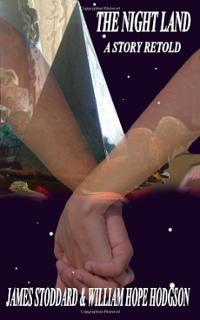 Stoddard provides additional details at his website, but really all I needed to hear was that the author of The High House had updated Hodgson for a contemporary audience.
Stoddard provides additional details at his website, but really all I needed to hear was that the author of The High House had updated Hodgson for a contemporary audience.
A few will undoubtedly see this sort of modernization as sacrilege, but it really struck a chord with me because I’d felt the exact same compulsion. Specifically, when I read Hodgson’s first novel The Boats of the Glen Carrig, I slogged through the distractingly overwritten narration pulled along only by the power of the story itself. And all the while I yearned to take it as an exhaustively written plot synopsis and write it into a novel proper — if nothing else, adding some dialogue and fleshing out the nameless crew into engaging characters.
Stoddard got enough requests from fans eager to read his rewrite that he relented and, in 2010, self-published The Night Land, A Story Retold and made it available through Amazon. (A little in-joke: he lists the publisher on the title page as “Ransom House.” Ransom Stoddard was the name of Jimmy Stewart’s character in The Man Who Shot Liberty Valance [1962]; Elwin Ransom is also the name of the university professor who is the main protagonist in C.S. Lewis’s Space Trilogy.)
The cover lists the authors as “James Stoddard & William Hope Hodgson.” There are three blurbs on the back, and although there is no distinction made, the quotes from The Bookman and from Lovecraft obviously pertain to Hodgon’s original text. The third blurb, from the Paranormal Romance Guild, is the only one directly from a review of this retold version.
So I’ve ordered a copy with the intent to review it for Black Gate. It arrived a couple days ago, along with the Wildside Press edition of the original. You see, I have a confession to make: while I’ve read a good deal of Hodgson (The House on the Borderland is one of my favorite sci-fi/weird horror novels), The Night Land is a peak I’ve never yet tackled. And I figured that if I’m going to give an intelligent assessment of Stoddard’s rewrite, I need to be familiar with the source text.
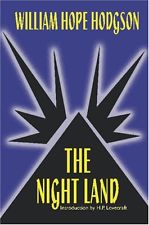 Now, with both volumes before me, here is my quandary: which do I read first? I really want to dive right into Stoddard’s, but should I first have the original under my belt? Or would it be more revealing to read the story retold while I still know only the barest outline of the story, and thus have no preconceptions?
Now, with both volumes before me, here is my quandary: which do I read first? I really want to dive right into Stoddard’s, but should I first have the original under my belt? Or would it be more revealing to read the story retold while I still know only the barest outline of the story, and thus have no preconceptions?
If you’ve read this post all the way to the end, I’m curious which order you would suggest. Whichever way I proceed, I’ll be back here with a full report once I return from my dual excursion to the far future of The Night Land.
If you’re thinking of taking the same trip, Hodgson’s work is now out of copyright and thus is available in multiple print and electronic editions. The Wildside Press edition I bought through Amazon for $15.21. The Night Land, A Story Retold, is available for $10.79 or $2.99 on Kindle.
Read the original first.
I’ve never had the problem with arcane language that others do. although I do find the relationship aspect a bit heavy.
But even if I did I’d read the original first – out of respect, and because I think it will give you a better perspective after reading both.
Enjoy.
I’d say at least start with the original. Then if you bounce off of it, move to Stoddard’s rewrite.
Night Shade published all of Hodgson’s fiction in a five-volume collection, all of which are currently available from Amazon or directly from Baen eBooks.
And if you want even more, there are two volumes of other people’s Night Land stories published by Andy Robertson — https://www.goodreads.com/book/show/634042.William_Hope_Hodgson_s_Night_Lands_Volume_I?from_search=true and https://www.goodreads.com/book/show/2346162.William_Hope_Hodgson_s_Night_Lands_Volume_2.
A non-Carnacki post about Hodgson. Interesting!
I *loved* most of The House on the Borderland, especially the set up and the middle. But the parts where time speeds up and he starts to float through space left me a little cold; it seemed a little to me like the author didn’t know quite how to bring the story to a conclusion.
Actually, I could often say the same about the works of Stephen King, and I would consider him a favorite author, and some of those works as favorites as well, so I guess a conclusion doesn’t have to be perfect for an artistic work to be excellent overall (um, the TV series “Lost” springs to mind too).
I should add, the “scientific” aspects of the portions where time speeds up and he floats through space are actually pretty amazing given the timeframe in which he wrote The House on the Borderland, pre-Einstein and all.
I couldn’t get through “The Night Land” myself. I did really enjoy “The House on the Borderland”, although I did felt like I became less interested as it became more bizarre.
I think “The Ghost Pirates” is a very underrated work by WHH. It’s much more accessible than either “The Night Land” or “The House on the Borderland”, and its setting on a sailing ship is described with such authenticity that it makes the weird stuff seem that much more plausible when it starts to happen (which I think Lovecraft would have appreciated).
I agree with everything Lovecraft said about it, both good and bad. An incredible vision, stodgy writing.
There’s also an incredible novella set in the same universe called Awake in the Night by John C. Wright that I would highly recommend.
The entire side Peadar linked to with that story — http://www.thenightland.co.uk/nightmap.html — is well worth your attention. It’s an amazing collection of fiction, art, essays, etc. about Hodgson’s book (and is the original source for the stories in both of the books I linked above).
You can also read Hodgson’s books at Project Gutenburg.
http://www.gutenberg.org/ebooks/author/3260
There are several other weird oldies there also. I really liked the house on the borderlands.
@ El Rey and Joe H: Thanks for the suggestion; I think I will start by dipping into the original. By the way, Joe, when I ordered these, I also picked up volume 2 of the NightShade collection, largely so I could have all the Carnacki the Ghost-Finder stories (there’s your reference to Carnacki, Sherlock!). Those are gorgeous editions.
@Allen Snyder: The weird time-warp sequence in House on the Borderland is truly bizarre — and psychedelic before that was even a word. It reminded me of scenes in Wells’s The Time Machine, but in Wells they made sense and were a natural outgrowth of the plot. In House on the Borderland, it just comes out of left field with no real rationale, other than being very cosmically trippy. I agree that the book feels somewhat like two completely different narratives strangely hinged together. (The Time Machine came out 13 years before the publication of House, and it could well be that Hodgson had just read that book and was strongly influenced by it as he tried to write his way to an ending for this story.) It’s fascinating, though, and now I really want to go back and revisit House to see if my mind can wrap around it all as a single piece that holds together. (I also concur that even if the whole time-rift in the book’s second half doesn’t quite hang with the rest, the book’s status is secure based on how damned creepy those weird pig-monsters are, and because being under siege by nameless terrors outside in the dark has rarely been better done.)
@Ebonsword: The verisimilitude Hodgson brings to his nautical tales is based on first-hand experience: He was a sailor for several years, working his way up from cabin-boy apprentice. Strangely enough, though, he seemed to have developed a loathing of the sea, so much so that when he volunteered to fight in WWI, he joined the Royal Artillery rather than serve in the Navy despite having a Third Mate’s certificate (according to Wikipedia). Ironically, he was killed by artillery, dying at the age of 40.
Things in his stories that his sailors encounter on uncharted islands and strange floating masses at sea are as slimy and disturbing as anything Lovecraft ever dreamed up (and some of Lovecraft’s more potent aquatic nightmares were clearly influenced by Hodgson). [Bizarre moment of synchronicity: Just as I typed that last sentence, someone on TV in the background referred to a “giant Cthulhu-like creature.” Some new reality show on SyFy. I glance up from my laptop to see they’re carving said creature from a giant pumpkin.]
@ peadarog, Joe H., and CMR: Thanks for the various links.
It is interesting that a sub-genre of “fanfic” has been established around The Night Land. It suggests that Hodgson created a setting so potent and impressive that it transcended the story itself, and that — like Middle-Earth or Barsoom or the Hyborian Age — other writers and artists want to play in it.
James Stoddard’s THE HIGH HOUSE sits in a place of pride on my book shelf. He’s a gifted writer and a fine fellow.
I’m like many of the others who bounced off of The Night Land. The Hodgson I loved was the writer of short stories. Some of the most eerie and haunting work I ever read came from Hodgson’s pen. Just about any one of his nautical stories will keep you on the edge of your seat. One literally had me on the edge of mine shouting at the book for the men to get out of that derelict ship they were on. Admittedly, I was in my late teens, but still, no other author before or since ever had that effect on me.
I’ve not read THE NIGHT LAND or THE HOUSE ON THE BORDERLAND, but I’ll echo what Howard says about the nautical stories. I’ve read some from the Nightshade volumes and loved them.
And thanks for the shout-out. I’m looking forward to your take on these books. I attended a few conventions that Stoddard was at shortly after THE HIGH HOUSE was published. I wish he would bring out the third volume himself. He’s a terrific writer.
[…] 30. Hodgson’s stilted prose moved even Lovecraft to declare that its “attempt at archaic language [is] grotesque and absurd.” Recently a cottage industry has emerged of fans taking their turn at trying to just re-write the damn’d thing; see this account. […]